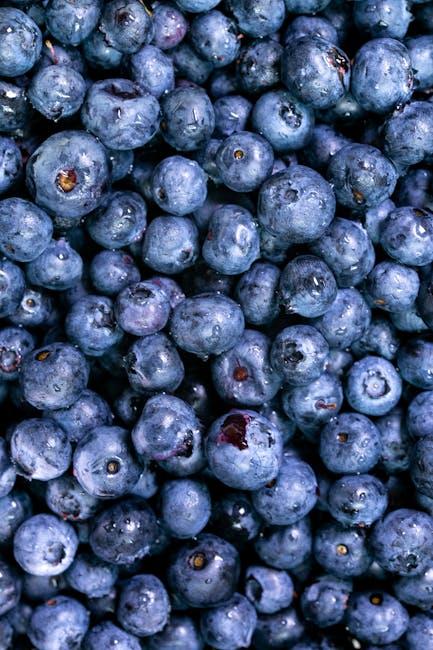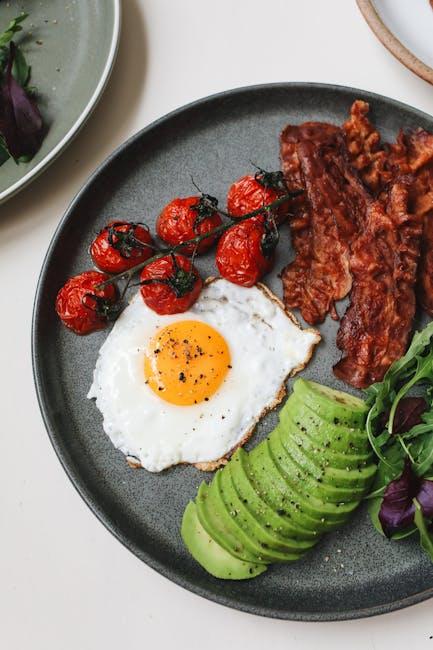In the fast-paced rhythm of modern life, finding time to plan and prepare meals can often feel like a daunting task—especially when following a specific diet like keto. Yet, the art of meal prepping offers a powerful solution, transforming the chaos of daily cooking into a seamless, stress-free routine. For those committed to the ketogenic lifestyle, mastering meal prep not only ensures nutritional goals are met but also turns the kitchen into a haven of creativity and efficiency. This guide will walk you through practical strategies and tasty ideas to help you embrace meal prepping on the keto diet, making healthy, low-carb living both accessible and enjoyable.
Understanding Keto Macros for Effective Meal Planning
Mastering the balance of macronutrients is the cornerstone of success on a keto diet. Fat should take the lead, making up approximately 70-75% of your daily calories, as it energizes your body and supports ketosis. Protein plays a crucial supporting role, generally around 20-25%, helping maintain muscle mass and satiety without kicking you out of ketosis. Carbohydrates are kept minimal, often below 5-10%, to ensure your body remains in fat-burning mode. Being mindful of these ratios empowers you to craft meals that not only satisfy your hunger but also steady your metabolic state.
When planning meals, consider incorporating foods that naturally fit into these macronutrient targets. Prioritize sources of healthy fats like avocado, olive oil, and fatty fish, along with moderate portions of high-quality proteins such as grass-fed beef or free-range chicken. Keep carbs in check by focusing on leafy greens and low-carb vegetables. Here’s a simple breakdown to visualize your keto macro goals:
| Macro | % of Daily Calories | Common Keto Foods |
|---|---|---|
| Fat | 70-75% | Avocado, Olive Oil, Butter |
| Protein | 20-25% | Chicken, Beef, Eggs |
| Carbs | 5-10% | Spinach, Broccoli, Cauliflower |
Choosing the Best Low Carb Ingredients for Keto Recipes
When assembling your keto meal prep list, focus on ingredients that keep your carb count low while maximizing flavor and nutrition. Opt for fresh, non-starchy vegetables like spinach, cauliflower, zucchini, and bell peppers—they’re versatile and packed with vitamins. Protein sources should lean towards high-quality options such as grass-fed beef, wild-caught fish, and free-range chicken, which provide essential amino acids without hidden carbs. Don’t forget to include healthy fats like avocado, olive oil, and nuts, vital for sustaining energy and satiety on a keto diet.
To help you visualize and compare, here’s a quick reference table of keto-friendly ingredients with their approximate net carbs per 100g:
| Ingredient | Net Carbs (g) | Keto Benefits |
|---|---|---|
| Spinach | 1.4 | High in iron and antioxidants |
| Cauliflower | 3 | Great rice substitute, fiber-rich |
| Avocado | 2 | Loaded with monounsaturated fats |
| Chicken Breast | 0 | Lean protein source |
| Almonds | 2 | Good source of healthy fats and fiber |
- Prioritize organic and whole-food sources to avoid added sugars and preservatives.
- Rotate your protein and veggie choices to keep meals interesting and nutrient-rich.
- Incorporate spices and herbs like turmeric, rosemary, and garlic to boost flavor without carbs.
Simple Batch Cooking Techniques to Save Time and Effort
When diving into keto meal prep, mastering batch cooking can drastically reduce daily kitchen time and keep your macros on track without stress. Start by choosing versatile proteins like chicken thighs, ground beef, or salmon that can be cooked in bulk and flavored differently throughout the week. Utilize large baking sheets or slow cookers, allowing you to cook multiple servings simultaneously. Incorporate low-carb vegetables such as broccoli, cauliflower, and zucchini, which roast well in large quantities and retain texture when reheated.
Organize your cooked ingredients into clear, labeled containers using the wp-block-table class for clean organization:
| Meal | Batch Cooked Item | Storage Tip |
|---|---|---|
| Keto Salad Bowls | Grilled chicken & roasted veggies | Keep dressings separate until serving |
| Breakfast Scramble | Cooked bacon & scrambled eggs | Store eggs in airtight containers |
| Creamy Alfredo Zoodles | Sautéed shrimp & zucchini noodles | Reheat gently to avoid sogginess |
Consistently repurposing these ingredients allows you to build variety without new cooking every day. Remember, keeping batch-cooked meals fresh is key—freeze portions you won’t eat within three days and thaw overnight to maintain that fresh-from-the-kitchen taste.
Portioning and Storing Your Meals for Maximum Freshness
Efficiently dividing your meals into perfectly sized portions is a game changer when sticking to keto. Start by using containers that suit your lifestyle—glass for reheating without hassle, or BPA-free plastic for grab-and-go convenience. Label each container with the meal name and the date prepped for easy tracking. This method maintains the crisp texture of your veggies and the tender juiciness of your proteins, ensuring every bite tastes freshly made.
Proper storage is key to preserving both flavor and nutritional integrity. Keep meals in airtight containers to ward off moisture and minimize oxidation, which can degrade fats—a crucial component on keto. Use the fridge for meals you’ll consume within four days, and freeze extras to stretch your prep even further. Here’s a quick reference to help you choose storage durations:
| Meal Type | Refrigerate | Freeze |
|---|---|---|
| Meat & Poultry | 3-4 days | 2-3 months |
| Cooked Vegetables | 3-5 days | 2 months |
| Fat-Based Sauces | 1 week | Not recommended |
- Tip: Thaw frozen keto meals overnight in the fridge, never at room temperature.
- Tip: Keep high-fat components, like cheese or avocado, separate until serving.
Incorporating Variety to Keep Your Keto Meal Prep Exciting
Keeping your keto meal prep fresh and stimulating is essential to maintaining enthusiasm and ensuring you stick to your low-carb lifestyle. One effective strategy is to rotate your protein sources regularly. Incorporate a variety of meats like chicken, beef, pork, and fatty fish to not only diversify flavors but also boost nutrient intake. Don’t forget plant-based fats and proteins such as avocados, nuts, and seeds, which add texture and essential nutrients. Introducing different herbs, spices, and flavored oils can transform the simplest dish into a gourmet experience without compromising your macros.
Variety can also be achieved visually and nutritionally by mixing up your side dishes. Try spiralized veggies, cauliflower rice, or sautéed greens in olive or coconut oil for rich flavors and satisfying crunch. Below is a quick overview of options that can make each keto meal prep session unique and exciting:
| Protein Options | Vegetable Sides | Flavor Enhancers |
|---|---|---|
| Grass-fed beef | Roasted Brussels sprouts | Smoked paprika |
| Salmon fillets | Cauliflower mash | Garlic-infused olive oil |
| Pulled pork | Sautéed kale | Fresh rosemary |
| Eggs & Avocado | Zucchini noodles | Crushed red pepper |
- Batch-cook large portions with distinct seasoning profiles.
- Mix and match your proteins and veggies to form new combinations.
- Experiment with textures by roasting, grilling, or steaming.
Q&A
Q: What exactly is the keto diet and why meal prep for it?
A: The keto diet is a low-carb, high-fat way of eating designed to shift your body into fat-burning mode, known as ketosis. Meal prepping on keto helps you stay on track by having ready-to-eat, perfectly portioned meals that fit your macros—making it easier to resist carb temptations and save time during busy days.
Q: How do I start meal prepping for keto if I’m new to it?
A: Begin by planning your week’s meals around keto-friendly ingredients like avocados, eggs, fatty fish, cheese, nuts, and leafy greens. Create a simple menu, shop for your essentials, and set aside a couple of hours to cook and portion meals ahead of time. Starting with three or four dishes you enjoy will keep things manageable.
Q: What are some easy keto meal prep staples to keep on hand?
A: Hard-boiled eggs, cooked bacon, grilled chicken thighs, roasted vegetables like cauliflower and zucchini, and homemade keto sauces or dressings are your best friends. They’re versatile, quick to prepare, and store beautifully in the fridge or freezer for convenient meals.
Q: How do I ensure my keto meals stay fresh throughout the week?
A: Invest in good-quality airtight containers and label meals with dates. Store salads and dressings separately to avoid sogginess, and freeze portions you won’t eat within 3-4 days. Fresh herbs and a squeeze of lemon or lime can also keep dishes vibrant and appetizing.
Q: Can I meal prep keto-friendly snacks too?
A: Absolutely! Prepare snacks like cheese sticks, nut butter packets, pepperoni slices, or homemade fat bombs. Having keto-approved snacks ready prevents impulsive snacking on high-carb options and keeps your energy steady.
Q: What’s the biggest challenge in keto meal prepping, and how do I overcome it?
A: The biggest hurdle is often boredom from repetitive meals. Overcome this by rotating different proteins, experimenting with spices and herbs, and trying new recipes. Keeping a diverse meal plan not only fuels your body but also keeps your taste buds engaged.
Q: How much time should I realistically allocate for keto meal prep each week?
A: Depending on your menu complexity, 2-4 hours once or twice a week is usually sufficient. This upfront investment saves countless daily meal decisions and cooks time later on.
Q: Is there a recommended portion size or macro ratio I should follow when prepping keto meals?
A: While individual needs vary, a typical keto ratio is approximately 70-75% fat, 20-25% protein, and 5-10% carbs. Tracking your macros with an app during meal prep can help you tailor portions for your goals.
Q: How can I keep keto meal prep interesting without spending too much money?
A: Plan meals around seasonal and sale items, use budget-friendly staples like eggs and canned fish, and make large batches to minimize waste. Creativity in the kitchen—think zoodles, cauliflower rice, or egg muffins—can keep things fresh and cost-effective.
Q: Any final tips for successful keto meal prepping?
A: Stay flexible and listen to your body. If a meal doesn’t excite you, tweak it or swap it out. Keep meals tasty and satisfying—after all, eating keto should be a sustainable, enjoyable lifestyle, not a chore.
Concluding Remarks
Mastering the art of meal prepping on the keto diet is less about strict rules and more about discovering a rhythm that works for you. With a little planning, creativity, and a dash of patience, you can transform your weekly meals into a seamless routine that supports your goals and satisfies your taste buds. Whether you’re reaching for creamy avocados or sizzling up some bacon, the key is consistency and adaptability. So, roll up your sleeves, stock your pantry, and let meal prepping be the steady foundation of your keto journey—one delicious, low-carb bite at a time.

